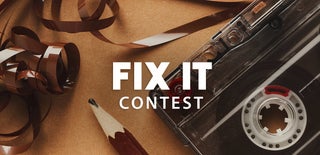Introduction: Fixing and Improving My Headset
I accidently dropped my bluetooth headset while charging and broke the micro USB port. I couldn't charge it anymore, and use it as a bluetooth headset, but only wired. So I decided to repair it. My model is an AKG N60 NC Wireless, that features a micro usb port (which is a bit old and less convenient than a usb c port).
However, this repair can be made for nearly every bluetooth or noise canceling headset.
In this tutorial I will explain how I replace the port and upgrade to a usb c port.
Supplies
Step 1: Open the Headset
Firstly, I removed the earpeace (for my model, it was only maintained by an elastic piece. Then I unscrewed 4 screws.
And you can see the battery and pcb, (inside bluetooth headsets they are often on the same side).
On the other side of the headset there's the media buttons, but they wont be changed so only one earpiece need to be removed.
Be very carefull since headsets use very thin cables for the speaker and the microphone (used for noise canceling).
Step 2: Remove the Existing Port
My headset charging port was a micro usb port. Since only few people have tools needed to unsolder and resolder a usb port (not my case), I had to remove the port with a rotary tool. Be very carefull when doing it because you need to remove the port without damaging the pcb that could lead to shorts.
The connections of the port remaining were a bit damaged but not shorted.
I couldn't manage to solder back wires on these connections, so I needed a new way of charging the battery.
Step 3: New Charging Circuit
In order to charge the battery I decided to use a TP4056 module, that can charge li-po batteries and even have a low voltage and short circuit protection. However, this module was too big to fit his port inside the existing hole, so I needed to have an extension cord. I decided to go with a usb C port instead of the micro usb port, since it's more durable and a lot more convenient. I purchased a usb-c extension cord, cut it in half an kept the usb female part. I needed to remove all the plastic from the cable, leaving it only with the port and the cables.
Then I identified the positive and negative wires of the port (you can easily find schematics of such a cable) , and I soldered these to wires to my charging module. And I also soldered the charging module to the battery very carefully to prevent short. Since I leave the battery soldered to the pcb, all the circuit protection systems of the baords stay active, and the battery status is still working.
Here a schematic of the simple connections.
Step 4: Put All Modules Inside
I needed to make place for the cable and the module, and enlarging the micro usb hole to fit the usb c port.
I fistly isolated all the modules with electrical tape to ensure no shorts.
Then I enlarged the hole until the port fitted with a bit of force (just enough that it maintain itself).
I just put a bit of glue on the port to ensure that it will support multiple plugging and unplugging.
Inside my headset there is just enough space to fit the charging module (that is very slim).
Step 5: Charging
I plugged in my headset using its new port, but the original charging indicator was obviously not lighting up since It's not used anymore. Only a bit of light from the new module was noticeable. Since I could'nt remove the tape, risking a short. I bought a usb c cable that has a light indicator on it, and that changes color depending of the charging status. This cable is optionnal, and after many charges, I know that it takes around 1h30 (for a 510mah battery) to fully charge so the indicator is not mandatory.
Now I have a still functionning headset, and future proof with its usb c port.

Participated in the
Fix It Contest







